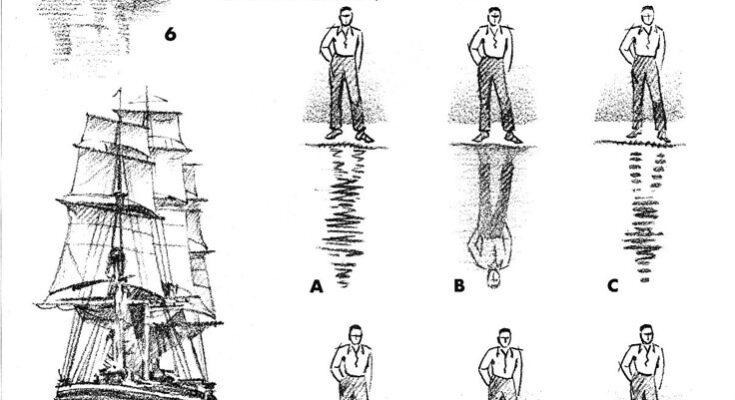Reflections Under Various Conditions: A Detailed Study of Water and Imagery
The interplay between water and its reflective properties offers a fascinating glimpse into the natural world’s subtleties. This detailed guide, accompanied by a series of insightful sketches, explores how reflections form under different water conditions, using an old sailing ship and human figures as focal points. Whether you’re an artist, a photographer, or simply an admirer of nature’s mirror-like qualities, this in-depth analysis provides a comprehensive understanding of how water surfaces interact with light and objects.
Introduction to Reflections
Figure 6 depicts an old sailing ship on still water, serving as the perfect subject for studying reflections. For all intents and purposes, the reflection below can be a duplicate of the ship above. When the water is calm, it sometimes helps to slightly darken the surroundings in the reflection to bring out its details. However, if the water were to become ruffled, the reflection could break into white (parallel strips). In this case, the bottom of the reflection might be longer and in fragments, because the tipping waves (like tipping mirrors) give several added surfaces to catch the image.
Below are simple sketches of a man standing on a shore’s edge, illustrating various water conditions and their impact on reflections:
1. Still Water Aligned with the Shore (Fig. A)
In Figure A, the water is undisturbed but not ruffled (windblown). The reflection is clear and aligns perfectly with the man standing on the shore, pushing toward shore in parallel wavelets. This calm condition ensures a near-perfect mirror image, with no distortion to obscure the subject’s details.
2. Windblown Water with Rough Breaking (Fig. B)
Figure B shows the water in a roughly broken state by a stiff breeze and has no reflection at all. The wind disrupts the surface, scattering light and preventing a cohesive reflection. This sketch highlights how even a moderate breeze can eliminate reflective properties entirely.
3. Only a Portion of the Water Reflects (Fig. C)
In Figure C, only a portion of the water is windblown (such a condition is more likely to happen over a wider area). The swift currents break reflection (more likely to happen in a stream than a lake), creating a patchy reflection. This illustrates how localized wind effects can create a mosaic of reflective and non-reflective zones.
4. “Rolling” Water with Good Reflections (Fig. 7)
Figure 7 introduces “rolling” water, which can still produce good reflections. The pencil lines should not be exactly parallel. The darkest lines are about the width of the ship, suggesting a gentle undulation that maintains reflective quality without complete disruption. This condition is ideal for capturing detailed images, as the slight movement adds depth without breaking the reflection.
5. Detailed Reflections of a Standing Figure (Figs. D, E, F)
The subsequent sketches (Figures D, E, and F) focus on a man standing by the water’s edge, with varying degrees of reflection clarity:
- Figure D: The water is calm, providing a near-perfect reflection of the man, mirroring his stance and posture with precision.
- Figure E: The reflection remains intact but shows slight distortions, likely due to minor ripples, adding a dynamic quality to the image.
- Figure F: The reflection is fragmented, with the water’s surface broken by stronger currents or wind, resulting in a disjointed but still recognizable image.
Practical Insights for Artists and Observers
These sketches serve as a valuable resource for artists and photographers looking to capture the essence of water reflections. The key takeaway is the sensitivity of reflections to water movement—still water offers the clearest images, while even gentle breezes can introduce complexity and fragmentation. When sketching or photographing, consider the water’s condition and adjust your technique accordingly, darkening reflections slightly or embracing the broken patterns for artistic effect.
This exploration, posted on July 03, 2025, at 02:30 AM EDT, invites you to observe these phenomena during your next visit to a lake, stream, or seaside. Experiment with different lighting and wind conditions to unlock the full potential of nature’s reflective canvas!



